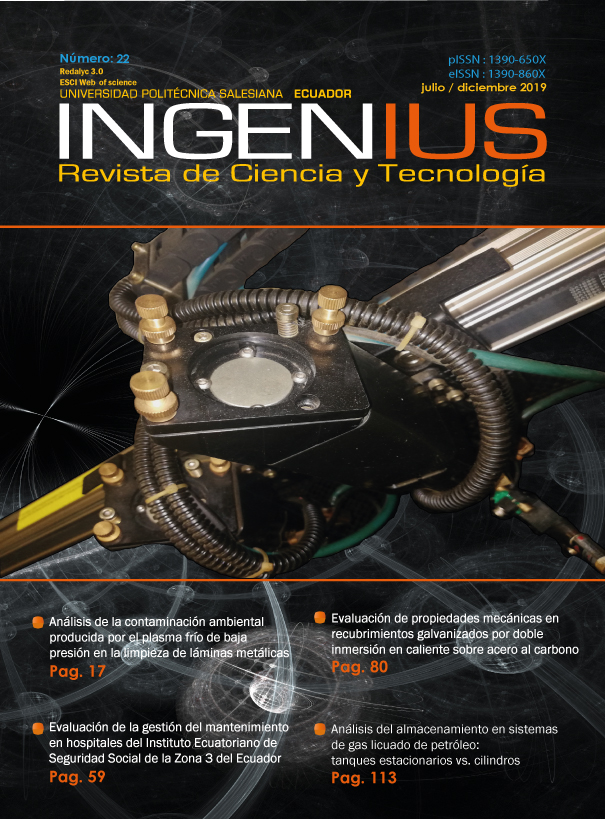Evaluation of Mechanical Properties in of Double-Dip Galvanized Coatings on Carbon Steel
Main Article Content
Abstract
Article Details
The Universidad Politécnica Salesiana of Ecuador preserves the copyrights of the published works and will favor the reuse of the works. The works are published in the electronic edition of the journal under a Creative Commons Attribution/Noncommercial-No Derivative Works 4.0 Ecuador license: they can be copied, used, disseminated, transmitted and publicly displayed.
The undersigned author partially transfers the copyrights of this work to the Universidad Politécnica Salesiana of Ecuador for printed editions.
It is also stated that they have respected the ethical principles of research and are free from any conflict of interest. The author(s) certify that this work has not been published, nor is it under consideration for publication in any other journal or editorial work.
The author (s) are responsible for their content and have contributed to the conception, design and completion of the work, analysis and interpretation of data, and to have participated in the writing of the text and its revisions, as well as in the approval of the version which is finally referred to as an attachment.
References
[2] E. Tzimas and G. Papadimitriou, “Cracking mechanisms in high temperature hot-dip galvanized coatings,” Surface and Coatings Technology, vol. 145, no. 1, pp. 176–185, 2001. [Online]. Available:
https://doi.org/10.1016/S0257-8972(01)01323-8
[3] V. Kuklík and J. Kudlácek, “2 - hot-dip galvanizing,” in Hot-Dip Galvanizing of Steel Structures. Boston: Butterworth-Heinemann, 2016, pp. 7–16. [Online]. Available: https://doi.org/10.1016/B978-0-08-100753-2.00002-1
[4] A. Marder, “The metallurgy of zinc-coated steel,” Progress in Materials Science, vol. 45, no. 3, pp. 191–271, 2000. [Online]. Available: https://doi.org/10.1016/S0079-6425(98)00006-1
[5] Y. Rico and E. J. Carrasquero, “Microstructural evaluation of double-dip galvanized coatings on carbon steel,” MRS Advances, vol. 2, no. 62, pp. 3917–3923, 2017. [Online]. Available: https://doi.org/10.1557/adv.2017.608
[6] S. Ploypech, P. Jearanaisilawong, and Y. Boonyongmaneerat, “Influence of thickness of intermetallic layers on fracture resistance of galvanized coatings,” Surface and Coatings Technology, vol. 223, pp. 1–5, 2013. [Online]. Available: https://doi.org/10.1016/j.surfcoat.2013.02.017
[7] ASTM, ASTM E290 - 14 Standard Test Methods for Bend Testing of Material for Conshohocken, PAASTM Std., 2014. [Online]. Available: http://bit.ly/2ZHgBvY
[8] Y. Rico O and E. Carrasquero, “Efecto de la composición química en el comportamiento mecánico de recubrimientos galvanizados por inmersión en caliente: una revisión,” INGENIUS, no. 18, pp. 30–39, 2017. [Online]. Available: https://doi.org/10.17163/ings.n18.2017.04
[9] ASTM, ASTM A123 / A123M-17, Standard Specification for Zinc (Hot-Dip Galvanized) Coatings on Iron and Steel Products, ASTM International, West Conshohocken, PA Std., 2017. [Online]. Available: http://bit.ly/2N4adgP
[10] C. E. Jordan and A. R. Marder, “Fe-Zn phase formation in interstitial-free steels hot-dip galvanized at 450 °C: Part i 0.00 wt% Al-Zn baths,” Journal of Materials Science, vol. 32, no. 21, pp. 5593–5602, Nov 1997. [Online]. Available: https://doi.org/10.1023/A:1018680625668
[11] P. Pokorny, J. Kolisko, L. Balik, and P. Novak, “Reaction kinetics of the formation of intermetallic Fe-Zn during hot - dip galvanizing of steel,” Metallurgy, vol. 55, no. 1, pp. 111–114, 2016. [Online]. Available: http://bit.ly/2XyXZAU
[12] S. Ploypech, Y. Boonyongmaneerat, and P. Jearanaisilawong, “Crack initiation and propagation of galvanized coatings hot-dipped at 450 °C under bending loads,” Surface and Coatings Technology, vol. 206, no. 18, pp. 3758–3763, 2012. [Online]. Available: https://doi.org/10.1016/j.surfcoat.2012.03.029
[13] M. Dutta, A. K. Halder, and S. B. Singh, “Morphology and properties of hot dip Zn-Mg and ZnMg-Al alloy coatings on steel sheet,” Surface and Coatings Technology, vol. 205, no. 7, pp. 2578–2584, 2010. [Online]. Available: https://doi.org/10.1016/j.surfcoat.2010.10.006
[14] N. Parvini Ahmadi and E. Rafiezadeh, “Effect of aluminum on microstructure and thickness of galvanized layers on low carbon silicon-free steel,” International Journal of Iron & Steel Society of Iran, vol. 6, no. 1, pp. 25–29, 2009. [Online]. Available: http://bit.ly/2ZBLLVh
[15] D. R. Raut and S. H. Poratkar, “Study the effect of aluminum variation on hardness & aluminum loss in Zn-Al alloy,” International Journal of Modern Engineering Research (IJMER), vol. 3, no. 2, pp. 884–887, 2013. [Online]. Available: http://bit.ly/2IxBPXc
[16] ASM, “Surface engineering,” ASM Interenational, 2002. [Online]. Available: http://bit.ly/2KD2RyT

